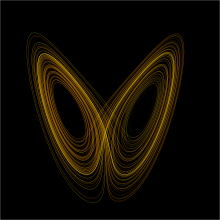Visualization
Appearance
Visualization or visualisation is the process of forming a mental image of something, envisioning something that is not present or is not tangible as if it were. It also refers to any technique for creating graphical representations to communicate information.
Quotes
[edit]A-F
[edit]

- Visualization is simply the creation of a strong mental image of the thing desired, the perfecting it each day until it becomes almost as clear as an existing material thing.
- William Walker Atkinson (1912), -The Secret of Mental Magic. p. 174
- For a musician, visualization is the process of picturing in our minds eye what we hear in our mind's ear. Visualization is something we all do. In fact, putting a visual form before the mind's eye or forming a mental image is something that precedes most things that we do.
- Jerry Bergonzi (1992), Melodic structures. p. 31
- Within the atom occur phenomena concerning which visualization is futile, to which common sense, the guidance from our everyday experience, has no application, which yield to studies by equations that have no meaning except that they work.
- Vannevar Bush (1967) Science is Not Enough'
- If statistical graphics, although born just yesterday, extends its reach every day, it is because it replaces long tables of numbers and it allows one not only to embrace at glance the series of phenomena, but also to signal the correspondences or anomalies, to find the causes, to identify the laws.
- Émile Cheysson (c. 1877), as cited in: Michael Friendly and Matthew Sigal, "Some Prehistory of CARME: Visual Language and Visual Thinking," in: Blasius, Jorg, and Michael Greenacre, eds. Visualization and verbalization of data. CRC Press, 2014. p. 3
- Only damaged people want good things to happen to them through visualization. They want something for nothing.
- Douglas Coupland (2006) JPod.
- While the film Life of Christ was rolling past before my eyes I was mentally visualizing the gods, Shri Krishna, Shri Ramachandra their Gokul and Ayodhya.. I was gripped by a strange spell. I bought another ticket and saw the film again. This time I felt my imagination taking shape in the screen. Could this really happen? Could we the sons of India, ever be able to see Indian images on the screen. The whole night passed in this mental agony.
- Dadasaheb Phalke After watching the film The Life of Christ in 1910 quoted in *Ganti, Tejaswini (5 March 2013). Bollywood: A Guidebook to Popular Hindi Cinema. Routledge. p. 92. ISBN 978-1-136-84929-9.
- Since geometry is the right foundation of all painting, I have decided to teach its rudiments and principles to all youngsters eager for art.
- Albrecht Dürer The Art of Measurement (1525).
- Our intellectual powers are rather geared to master static relations and that our powers to visualize processes evolving in time are relatively poorly developed. For that reason we should do (as wise programmers aware of our limitations) our utmost to shorten the conceptual gap between the static program and the dynamic process, to make the correspondence between the program (spread out in text space) and the process (spread out in time) as trivial as possible.
- Edsger W. Dijkstra (1968) "A Case against the GO TO Statement" cited in: Bill Curtis (1981) Tutorial, human factors in software development. p. 109.
- No man can visualize four dimensions, except mathematically … I think in four dimensions, but only abstractly. The human mind can picture these dimensions no more than it can envisage electricity. Nevertheless, they are no less real than electro-magnetism, the force which controls our universe, within, and by which we have our being.
- Albert Einstein (1929) Viereck interview'
G-L
[edit]

- Graham Greene
- To understand animal thinking you've got to get away from a language. See my mind works like Google for images. You put in a key word; it brings up pictures. See language for me narrates the pictures in my mind. When I work on designing livestock equipment I can test run that equipment in my head like 3-D virtual reality. In fact, when I was in college I used to think that everybody was able to do that. And language just sort of, you know, gives an opinion. Like, oh, that's a good idea or oh, I just figured out how to design that.
- Temple Grandin “A Conversation with Temple Grandin”, ‘’Talk of the Nation’’ with Ira Flatow, NPR, (January 20, 2006)
- When you visualized a man or woman carefully, you could always begin to feel pity — that was a quality God's image carried with it. When you saw the lines at the corners of the eyes, the shape of the mouth, how the hair grew, it was impossible to hate. Hate was just a failure of imagination.
- Graham Greene (1940) The Power and the Glory.
- However the development proceeds in detail, the path so far traced by the quantum theory indicates that an understanding of those still unclarified features of atomic physics can only be acquired by foregoing visualization and objectification to an extent greater than that customary hitherto...
- Werner Heisenberg (1933) The Development of Quantum Mechanics.
- God desires to indwell in my whole and total heart and cannot in any way tolerate my having an image in my mind's eye.
- Andreas Karlstadt, On the Removal of Images (1522), p. 117
- The nature of the pigments provides the basis for sensations of light and color; that is, brightness, hue and saturation. The geometrical demarcation of these qualities provide the physical basis for perception of areas and their shapes. Altogether, these factors constitute the vocabulary of the language of vision, and are acting as the optical forces of attraction.
- György Kepes (1944/1995) Language of vision. p. 16; as cited in: Yuri Engelhardt (2002) The Language of Graphics: A Framework for the Analysis of Syntax and Meaning in Maps, Charts and Diagram. p. 25.
- The medium of printed scientific text is first of all a visual one.
- Jay L. Lemke (1998) "Multiplying meaning: Visual and verbal semiotics in scientific text." In J. R. Martin & R. Veel (Eds.), Reading science: Critical and functional perspectives on discourses of science. London: Routledge. p. 95
M-R
[edit]

- Understanding how maps work and why maps work (or do not work) as representations in their own right and as prompts to further representations, and what it means for a map to work, are critical issues as we embark on a visual information age.
- Alan MacEachren (2004) How maps work: representation, visualization, and design. Guilford Press. p.v
- Writing turned a spotlight on the high, dim Sierras of speech; writing was the visualization of acoustic space. It lit up the dark.
- Marshall McLuhan (1969) Counterblast. p. 14.
- I attack both from the logic-side, scribbling outline after outline, and the long-walk relaxed-visualization-side, and while neither alone is enough, the combination synergizes. Which is just a fancy way of saying, "I think about it a lot, day and night."
- Lois McMaster Bujold (2008) "Publishing, Writing, and Authoring" in: The Vorkosigan Companion, p. 67
- It's not like you just have any old hallucination, you'll have a visualisation of exactly what the ritual is set up to provide, so if you summon the Greek god Hermes you will see the Greek god Hermes. But I began to get different ideas about what these things really were and I was more interested in the effect rather than the explanation because I didn't believe in gods or devils or demons, but I knew that there was something - these were like mechanisms, these rituals that could trigger states of mind.
- Grant Morrison "Full and Uncut Interview With Grant Morrison" Comicbookgrrrl, (09/29/2011).
- One of the curious psychological facts, in connection with the various ways in which various minds function, is the fact that when in these days we seek to visualize, in some pictorial manner, our ultimate view of life, the images which are called up are geometrical or chemical rather than anthropomorphic. It is probable that even the most rational and logical among us as soon as he begins to philosophize at all is compelled by the necessity of things to form in the mind some vague pictorial representation answering to his conception of the universe.
Most minds see the universe of their mental conception as something quite different from the actual stellar universe upon which we all gaze. Even the most purely rational minds who find the universe in "pure thought" are driven against their rational will to visualize this "pure thought" and to give it body and form and shape and movement.- John Cowper Powys (1920) The Complex Vision Chapter I.
- I think a picture is more like the real world when it is made out of the real world.
- Robert Rauschenberg, quoted in: Kenneth Coutts-Smith (1970) The dream of Icarus, p. 53.
- We are frequently faced with the necessity of looking for the picture required for the visualization of an object, not in the perception of this particular object, but in a different perceptual image. ...we can assert the discrepancy between the perceived picture and the objective state. This discrepancy... proves absolutely nothing against the fact that all visualizations are merely sense qualities of the perceptual space. ...If the parallelism is ...to be visualized, we must supplement our assertion by the description of certain qualities with which we are familiar from perceptual space.
- Hans Reichenbach (1928) The Philosophy of Space and Time.
- There is no pure visualization in the sense of a priori philosophies; every visualization is determined by previous sense perceptions, and any separation into perceptual space and space of visualization is not permissible, since the specifically visual elements of the imagination are derived from perceptual space. What led to the mistaken conception of pure visualization was rather an improper interpretation of the normative function... an essential element of all visual representations. Indeed, all arguments which have been introduced for the distinction of perceptual space and space of visualization are base on this normative component of the imagination.
- Hans Reichenbach (1928) The Philosophy of Space and Time
S-Z
[edit]
- For some queer and deplorable reason most human beings are more impressed by words than by figures, to the great disadvantage of mankind.
- Jan Tinbergen. "The necessity of quantitative social research." Sankhyā: The Indian Journal of Statistics, Series B (1973): 141-148.
- Imagery played a central role in theories of the mind for centuries. For example, the British Associationists conceptualizes thought itself as sequences of images. And, Wilhelm Wundt, the founder of scientific psychology, emphasized the analysis of images. However, the central role of imagery in theories of mental activity was undermined when Kulpe, in 1904, pointed out that some thoughts are not accompanied by imagery (e.g., one is not aware of the processes that allow one to decide which of two objects is heavier).
- Robert Andrew Wilson, Frank C. Keil (2001), The MIT Encyclopedia of the Cognitive Sciences. p. 387
- To name is to make visible.
- Margaret Wheatley, Deborah Frieze (2011) Walk Out Walk On: A Learning Journey into Communities Daring to Live the Future Now. p. 31.


